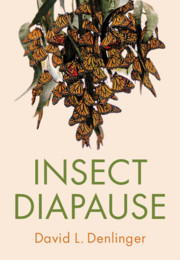Book contents
- Insect Diapause
- Insect Diapause
- Copyright page
- Dedication
- Contents
- Preface
- 1 Confronting the Challenges of a Seasonal Environment
- 2 Which Seasons Are Being Avoided?
- 3 Variation in the Diapause Response
- 4 The Cost of Diapause and Some Diapause Alternatives
- 5 Interpreting Seasonal Cues to Program Diapause Entry
- 6 Preparing for Diapause
- 7 The Diapause State
- 8 Ending Diapause and Reinitiating Development
- 9 Molecular Signaling Pathways that Regulate Diapause
- 10 Genetic Control of Diapause
- 11 Evolution of Diapause
- 12 Wider Implications
- References
- Species Index
- Subject Index
- Plate Section (PDF Only)
9 - Molecular Signaling Pathways that Regulate Diapause
Published online by Cambridge University Press: 13 January 2022
- Insect Diapause
- Insect Diapause
- Copyright page
- Dedication
- Contents
- Preface
- 1 Confronting the Challenges of a Seasonal Environment
- 2 Which Seasons Are Being Avoided?
- 3 Variation in the Diapause Response
- 4 The Cost of Diapause and Some Diapause Alternatives
- 5 Interpreting Seasonal Cues to Program Diapause Entry
- 6 Preparing for Diapause
- 7 The Diapause State
- 8 Ending Diapause and Reinitiating Development
- 9 Molecular Signaling Pathways that Regulate Diapause
- 10 Genetic Control of Diapause
- 11 Evolution of Diapause
- 12 Wider Implications
- References
- Species Index
- Subject Index
- Plate Section (PDF Only)
Summary
Hormones and downstream components of molecular signaling pathways that dictate entry and exit from diapause vary depending on the stage of diapause. Diapause hormone, a neuropeptide, directs entry into embryonic diapause in the silk moth, but embryonic diapauses in other species appear to be regulated by ecdysteroids or juvenile hormones. Larval and pupal diapauses are commonly initiated by a shutdown in the brain-prothoracic gland axis, reflected in failure of the prothoracic gland to produce ecdysone. Adult diapauses commonly are prompted by a failure of the corpora allata to produce the juvenile hormone needed for reproduction. Insulin signaling is central to diapause, and transcription factors such as FoxO provide a pathway to explain how a single hormone response can lead to the multiple downstream effects elicited by the diapause program. Organ cross talk, epigenetics, and small noncoding RNAs have emerged more recently as important new dimensions in the regulatory scheme of diapause.
Keywords
- Type
- Chapter
- Information
- Insect Diapause , pp. 240 - 292Publisher: Cambridge University PressPrint publication year: 2022
- 4
- Cited by

